Impact-Asymmetric Analysis of Bike-Sharing Residents’ Satisfaction: A Case Study of Harbin, China
Abstract
:1. Introduction
2. Literature Review
3. Data and Methods
3.1. Data and Variables
3.2. Analytical Methods
4. Discussion
4.1. Contribution of Travel Environment Elements to Overall Satisfaction
- Range of the impact on overall satisfaction (RIOS) = POSSs − POSSd
- Satisfaction-generating potential (SGP) = (POSSs − POSSn)/RIOS
- Dissatisfaction-generating potential (DGP) = (POSSn − POSSd)/RIOS
- Impact-asymmetry (IA) index = SGP − DGP
4.2. Impact-Asymmetric Analysis
4.3. Differentiation Analysis of New and Old Urban Areas
5. Conclusions
Author Contributions
Funding
Institutional Review Board Statement
Informed Consent Statement
Data Availability Statement
Acknowledgments
Conflicts of Interest
References
- 2020 Harbin National Economic and Social Development Statistical Bulletin. Available online: http://www.harbin.gov.cn/art/2021/4/30/art_25924_1099261.html (accessed on 25 October 2022).
- 2021 Harbin National Economic and Social Development Statistical Bulletin. Available online: http://www.harbin.gov.cn/art/2022/5/18/art_25924_1259352.html (accessed on 25 October 2022).
- Annual China Urban Traffic Report 2021. Available online: https://jiaotong.baidu.com/cms/reports/traffic/2021/index.html (accessed on 27 October 2022).
- Qin, J. Study on the Alleviating Effect of Shared Mobility on Urban Traffic Congestion; Harbin Institute of Technology: Harbin, China, 2021. [Google Scholar]
- Li, J.; Ma, M.; Xia, X.; Ren, W. The Spatial Effect of Shared Mobility on Urban Traffic Congestion: Evidence from Chinese Cities. Sustainability 2021, 13, 4065. [Google Scholar] [CrossRef]
- Macioszek, E.; Cieśla, M. External Environmental Analysis for Sustainable Bike-Sharing System Development. Energies 2022, 15, 791. [Google Scholar] [CrossRef]
- Macioszek, E.; Granà, A. The Analysis of the Factors Influencing the Severity of Bicyclist Injury in Bicyclist-Vehicle Crashes. Sustainability 2022, 14, 215. [Google Scholar] [CrossRef]
- Sun, X.L. A Study on Automotive-Bicycle Traffic Accident Analysis and Simulation; Harbin Institute of Technology: Harbin, China, 2015. [Google Scholar]
- Sorkou, T.; Tzouras, P.G.; Koliou, K.; Mitropoulos, L.; Karolemeas, C.; Kepaptsoglou, K. An Approach to Model the Willingness to Use of E-Scooter Sharing Services in Different Urban Road Environments. Sustainability 2022, 14, 15680. [Google Scholar] [CrossRef]
- Mo, H.; Wei, Z.; Zhai, Q. Travel Behaviors and Influencing Factors of Bike Sharing in Old Town: The Case of Guangzhou. South. Archit. 2019, 1, 7–12. [Google Scholar] [CrossRef]
- Sener, I.N.; Eluru, N.; Bhat, C.R. An analysis of bicycle route choice preferences in Texas, US. Transportation 2009, 36, 511–539. [Google Scholar] [CrossRef] [Green Version]
- Winters, M.; Davidson, G.; Kao, D.; Teschke, K. Motivators and deterrents of bicycling: Comparing influences on decisions to ride. Transportation 2011, 38, 153–168. [Google Scholar] [CrossRef]
- Li, Z.; Wang, W.; Liu, P.; Ragland, D. Physical environments influencing bicyclists’perception of comfort on separated and on-street bicycle facilities. Transp. Res. Part D Transp. Environ. 2012, 17, 256–261. [Google Scholar] [CrossRef]
- Hull, A.; O’ Holleran, C. Bicycle infrastructure: Can good design encourage cycling? Urban Plan Transp. Res. 2014, 2, 369–406. [Google Scholar] [CrossRef] [Green Version]
- Pan, H.J.; Zhu, W.; Wang, D. Evaluation and Improvement of Bicycle Travel Environment Based on the Cycling Route Choice Behavior. Shanghai Urban Plan. Rev. 2014, 2, 12–18. [Google Scholar] [CrossRef]
- Guo, C. Research of Cyclists’ Satisfaction on Urban Road; Chang ‘an University: Xi’an, China, 2014. [Google Scholar] [CrossRef]
- Zhu, W.; Zhai, B.X.; Jian, D. Evaluation and Optimization of Urban Bicycle Travel Environment based on a Visualized SP Method: Model construction and application in central Shanghai. Urban Plan. Forum. 2016, 3, 85–92. [Google Scholar] [CrossRef]
- Guo, Y.; Zhou, J.-B.; Wu, Y.; Li, Z. Identifying the factors affecting bike-sharing usage and degree of satisfaction in Ningbo, China. PLoS ONE 2017, 12, 1851. [Google Scholar] [CrossRef] [PubMed] [Green Version]
- Zhou, S.M. Study on Influence Factors of Satisfaction of Shared Bicycle User: In the Case of Kunming. Logist. Technol. 2017, 36, 35–39. [Google Scholar] [CrossRef]
- Hardinghaus, M.; Papantoniou, P. Evaluating Cyclists’ Route Preferences with Respect to Infrastructure. Sustainability 2020, 12, 3375. [Google Scholar] [CrossRef] [Green Version]
- Xu, J.; Xu, M.; Zhang, L.; Guo, J. Research on Construction and Activation of Cyclist Satisfaction Model. Mod. Urban Res. 2021, 5, 77–82. [Google Scholar] [CrossRef]
- Liu, Y. Research on the Impact of Residents’ Travel Behavior Based on the Improvement of Cycling Environment on Bicycle Tracks; Beijing Jiaotong University: Beijing, China, 2021. [Google Scholar]
- Qian, J.; Wang, D.; Niu, Y. Analysis of factors influencing urban residents’ satisfaction with the use of public bicycles in the city: A case study of Suzhou City. Geogr Res. 2014, 33, 358–371. [Google Scholar] [CrossRef]
- Feng, Y. Survey Research on Urban Residents’ Satisfaction with Shared Bicycles: Based on Survey Data of Nanchang City in 2017. Res. World 2018, 7, 13–18. [Google Scholar] [CrossRef]
- Li, F.Y.; Zhang, R.F. Significance Degree of Customer Demands of Sharing Bike Based on Kano Model. Packag. Eng. 2018, 39, 5. [Google Scholar] [CrossRef]
- Zhang, C.; Cao, X.; Nagpure, A.; Agarwal, S. Exploring rider satisfaction with transit service in Indore, India: An application of the three-factor theory. Transp. Lett. Int. J. Transp. Res. 2019, 11, 469–477. [Google Scholar] [CrossRef]
- Cui, J.C.; Fang, B.; Ren, Y. Influence Factors of Residents’ Commuting Satisfaction Based on Structural Equation Model: A Case Study of Yangzhou. Mod. Urban Res. 2018, 4, 115–122. [Google Scholar] [CrossRef]
- Cao, J.; Cao, X. Comparing importance-performance analysis and three-factor theory in assessing rider satisfaction with transit. J. Transp. Land Use 2017, 10, 65–68. [Google Scholar] [CrossRef] [Green Version]
- Fang, D.W.; Wang, X.; Sun, S. Optimization Strategies of Bus Transit Service Quality Based on IPA-Kano Model: A Case Study of Public Transport in Harbin. Sci. Technol. Eng. 2020, 20, 13454–13459. [Google Scholar]
- Sun, S.; Fang, D.W.; Cao, J. Exploring the asymmetric influences of stop attributes on rider satisfaction with bus stops. Travel. Behav. Soc. 2020, 19, 162–169. [Google Scholar] [CrossRef]
- Yin, J.B.; Cao, J.; Huang, X.Y. Association between subway and life satisfaction: Evidence from Xi’ an, China. Transp. Res. Part D Transp. Environ. 2021, 96, 102869. [Google Scholar] [CrossRef]
- Kano, N.; Seraku, N.; Takahashi, F.; Tsuji, S. Attractive quality and must-be quality. J. Jpn. Soc. Qual. Control 1984, 14, 39–48. [Google Scholar]
- Berger, C.; Blauth, R.; Boger, D. Kano’s methods for understanding customer-defined quality. Cent. Qual. Manag. J. 1993, 2, 3–35. [Google Scholar]
- Matzler, K.; Sauerwein, E.; Heischmidt, K. Importance-performance analysis revisited: The role of the factor structure of customer satisfaction. Serv. Ind J. 2003, 23, 112–129. [Google Scholar] [CrossRef]
- Mikuli, J.; Prebeac, D. Prioritizing improvement of service attributes using impact range-performance analysis and impact-asymmetry analysis. Manag. Serv. Qual. 2008, 18, 559–576. [Google Scholar] [CrossRef]
- Wu, X.; Cao, X.; Ding, C. Exploring rider satisfaction with arterial BRT: An application of impact asymmetry analysis. Travel. Behav. Soc. 2020, 19, 82–89. [Google Scholar] [CrossRef]
- Fang, D.; Xue, Y.; Cao, J.; Sun, S. Exploring satisfaction of choice and captive bus riders: An impact asymmetry analysis. Transp. Res. Part D Transp. Environ. 2021, 93, 102798. [Google Scholar] [CrossRef]
- Friedman, J.H. Greedy Function Approximation: A Gradient Boosting Machine. Ann. Stat. 2000, 29, 1189–1232. [Google Scholar] [CrossRef]
- Ding, C.; Wu, X.; Yu, G.; Wang, Y. A gradient boosting logit model to investigate driver’s stop-or-run behavior at signalized intersections using high-resolution traffic data. Transp. Res. Part C Emerg. Technol. 2016, 72, 225–238. [Google Scholar] [CrossRef]
- Zhang, Y.; Haghani, A. A gradient boosting method to improve travel time prediction. Transp. Res. Part C Emerg. Technol. 2015, 58, 308–324. [Google Scholar] [CrossRef]
- Dong, W.; Cao, X.; Wu, X.; Dong, Y. Examining pedestrian satisfaction in gated and open communities: An integration of gradient boosting decision trees and impact-asymmetry analysis. Landsc. Urban Plan. 2019, 185, 246–257. [Google Scholar] [CrossRef]
- Ding, C.; Cao, X.; Næss, P. Applying gradient boosting decision trees to examine non-linear effects of the built environment on driving distance in Oslo. Transp. Res. Part A Policy Pract. 2018, 110, 107–117. [Google Scholar] [CrossRef]
- Tao, T.; Wang, J.Y.; Cao, X.Y. Exploring the non-linear associations between spatial attributes and walking distance to transit. J. Transp. Geogr. 2020, 82, 102560. [Google Scholar] [CrossRef]
- Zhang, W.; Zhao, Y.; Cao, X.; Lu, D.; Chai, Y. Nonlinear effect of accessibility on car ownership in Beijing: Pedestrian-scale neighborhood planning-ScienceDirect. Transp. Res. Part D Transp. Environ. 2020, 86, 102445. [Google Scholar] [CrossRef]
- Shao, Q.; Zhang, W.; Cao, X.; Yang, J.; Yin, J. Threshold and moderating effects of land use on metro ridership in Shenzhen: Implications for TOD planning. J. Transp. Geogr. 2020, 89, 102878. [Google Scholar] [CrossRef]
- Lee, J.S.; Min, C.K. Prioritizing convention quality attributes from the perspective of three-factor theory: The case of academic association convention. Int. J. Hosp. Manag. 2013, 35, 282–293. [Google Scholar] [CrossRef]
- Lai, I.; Hitchcock, M. Sources of satisfaction with luxury hotels for new, repeat, and frequent travelers: A PLS impact-asymmetry analysis. Tour. Manag. 2017, 60, 107–129. [Google Scholar] [CrossRef]
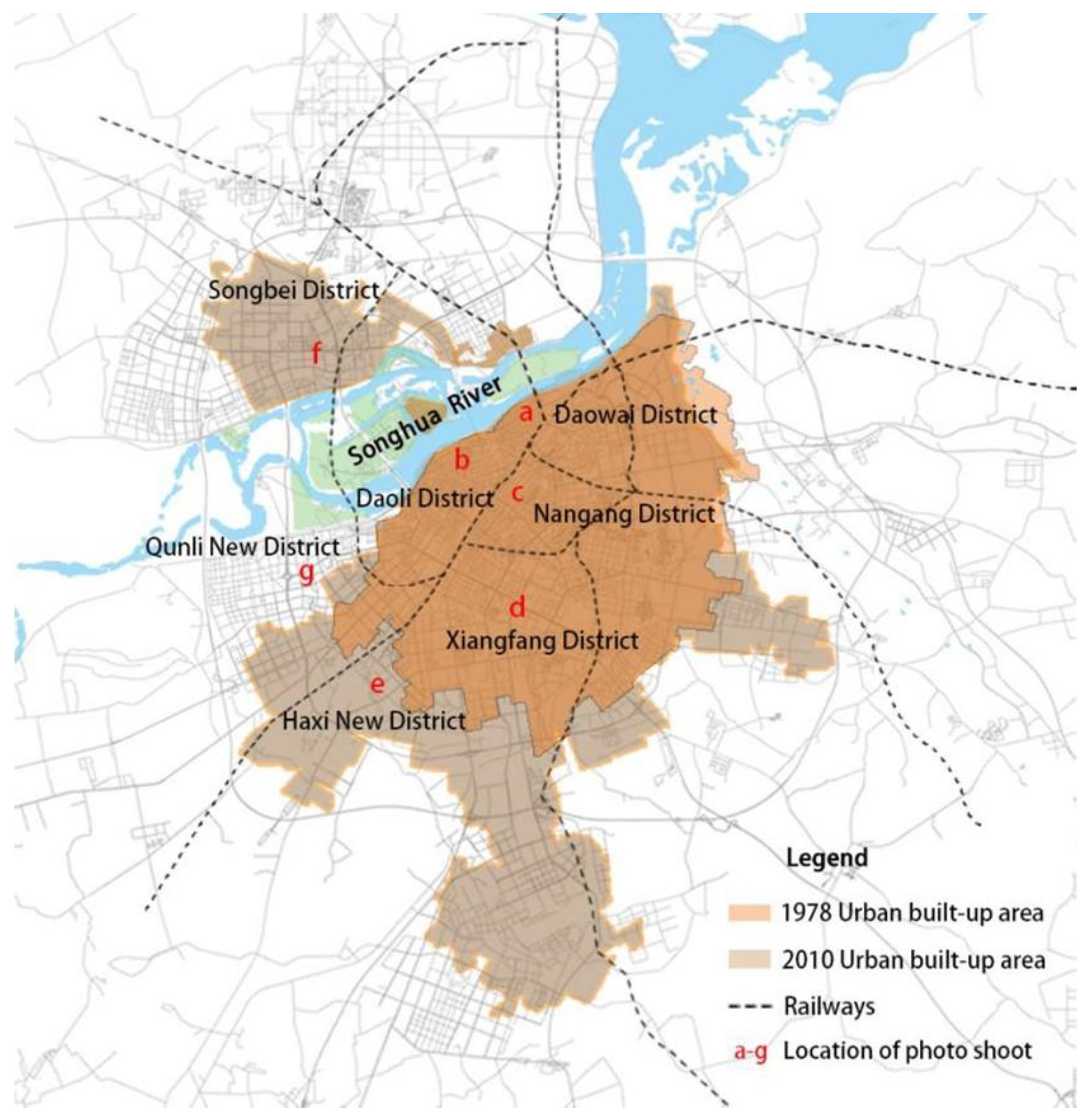
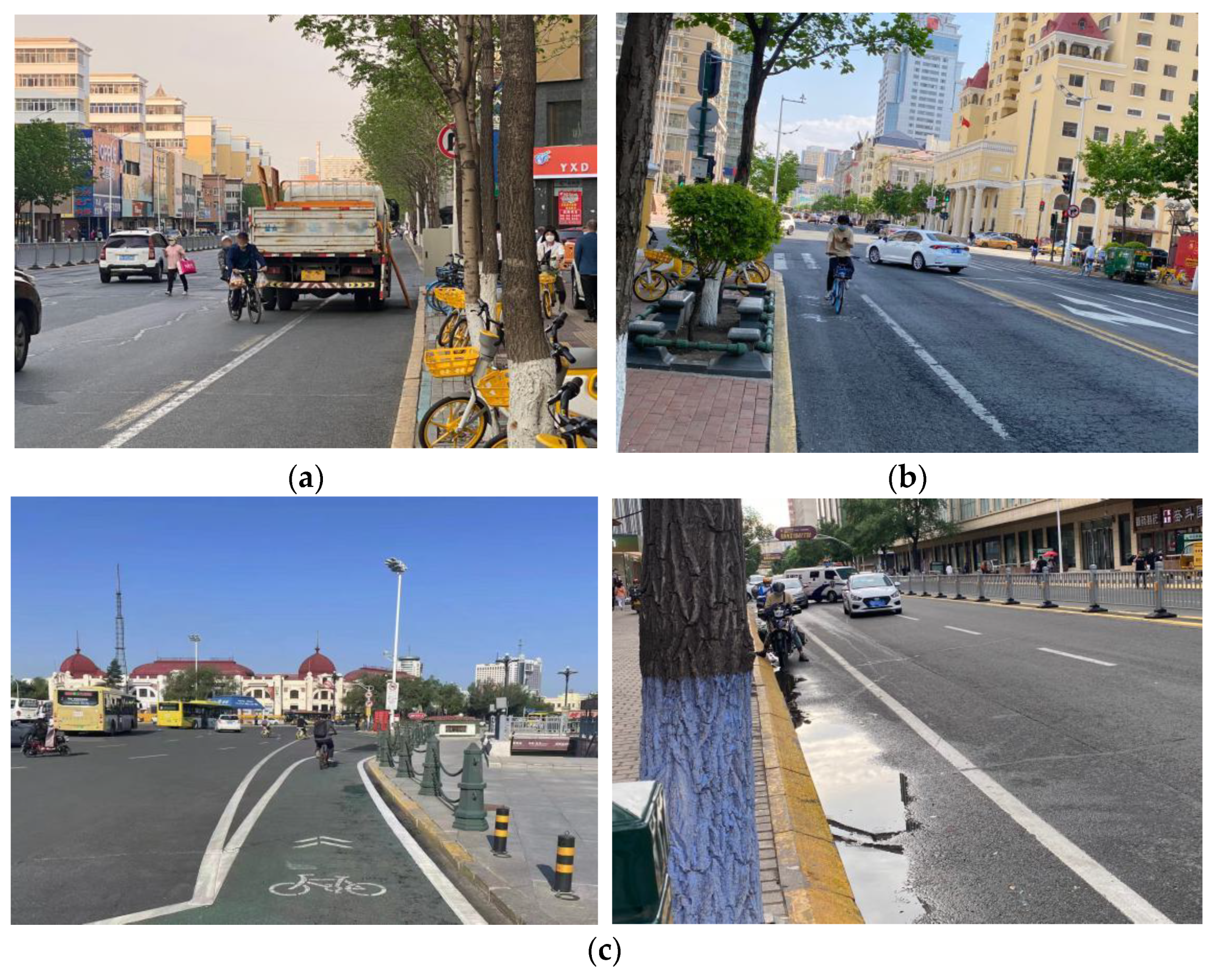


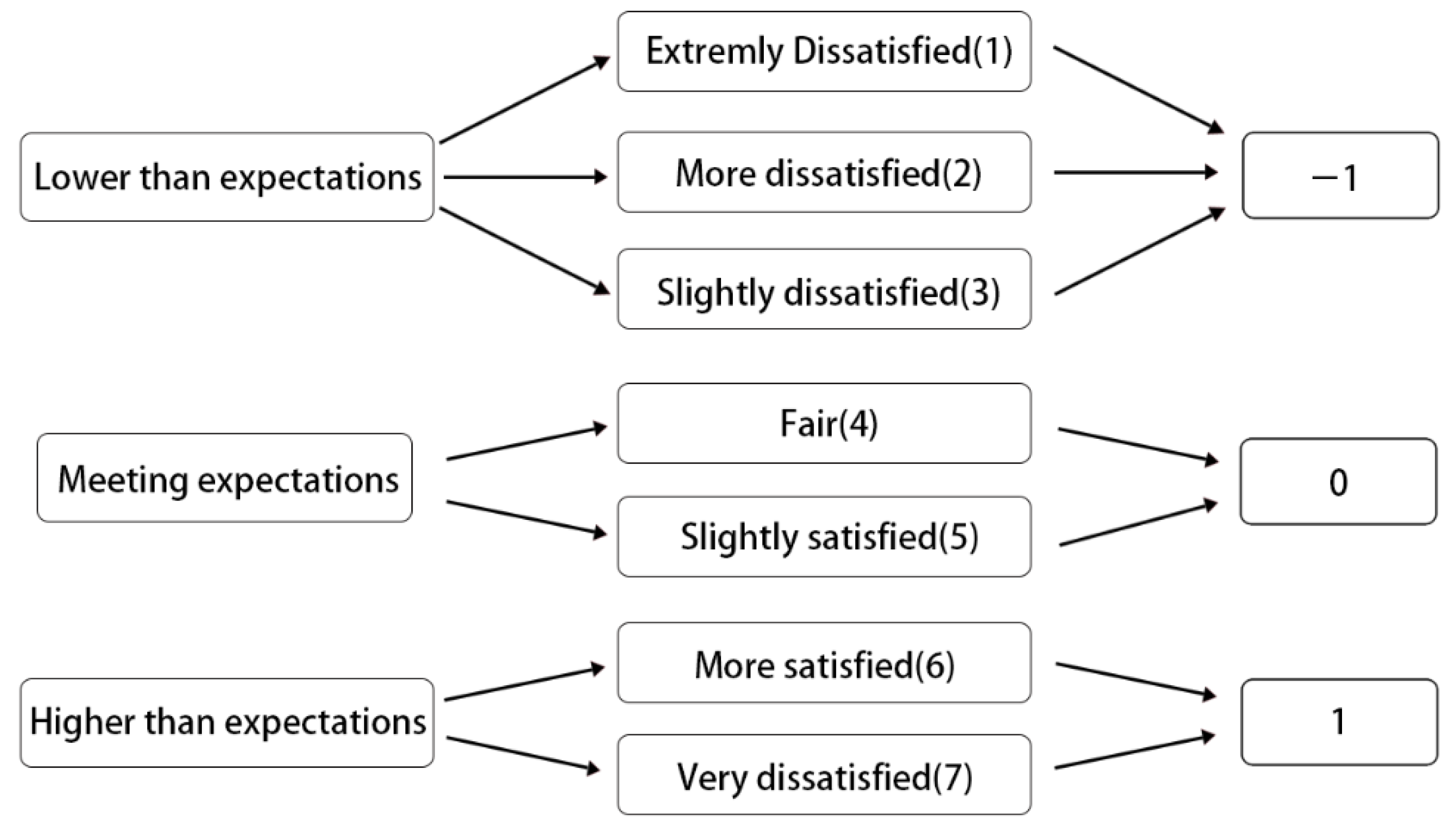
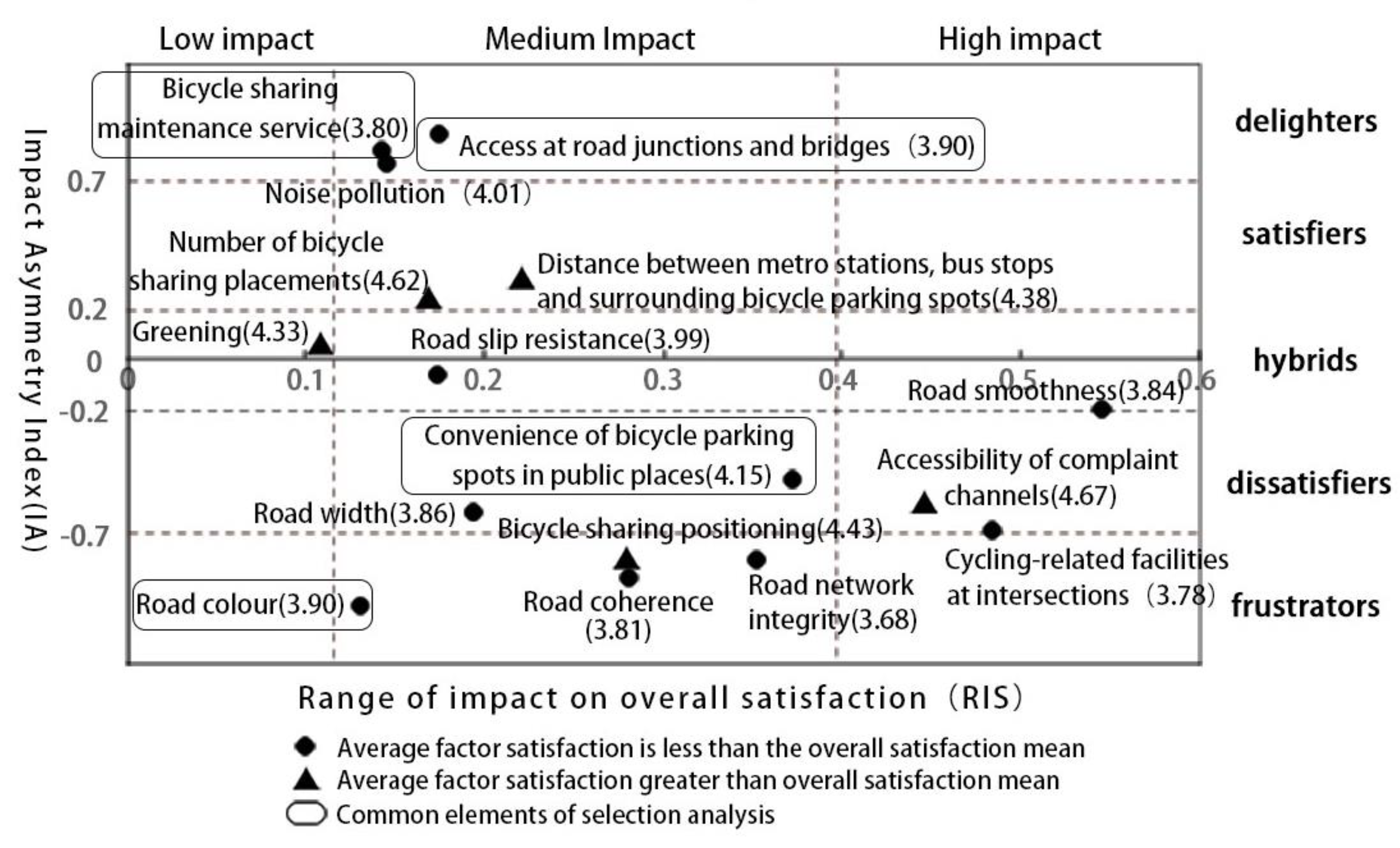
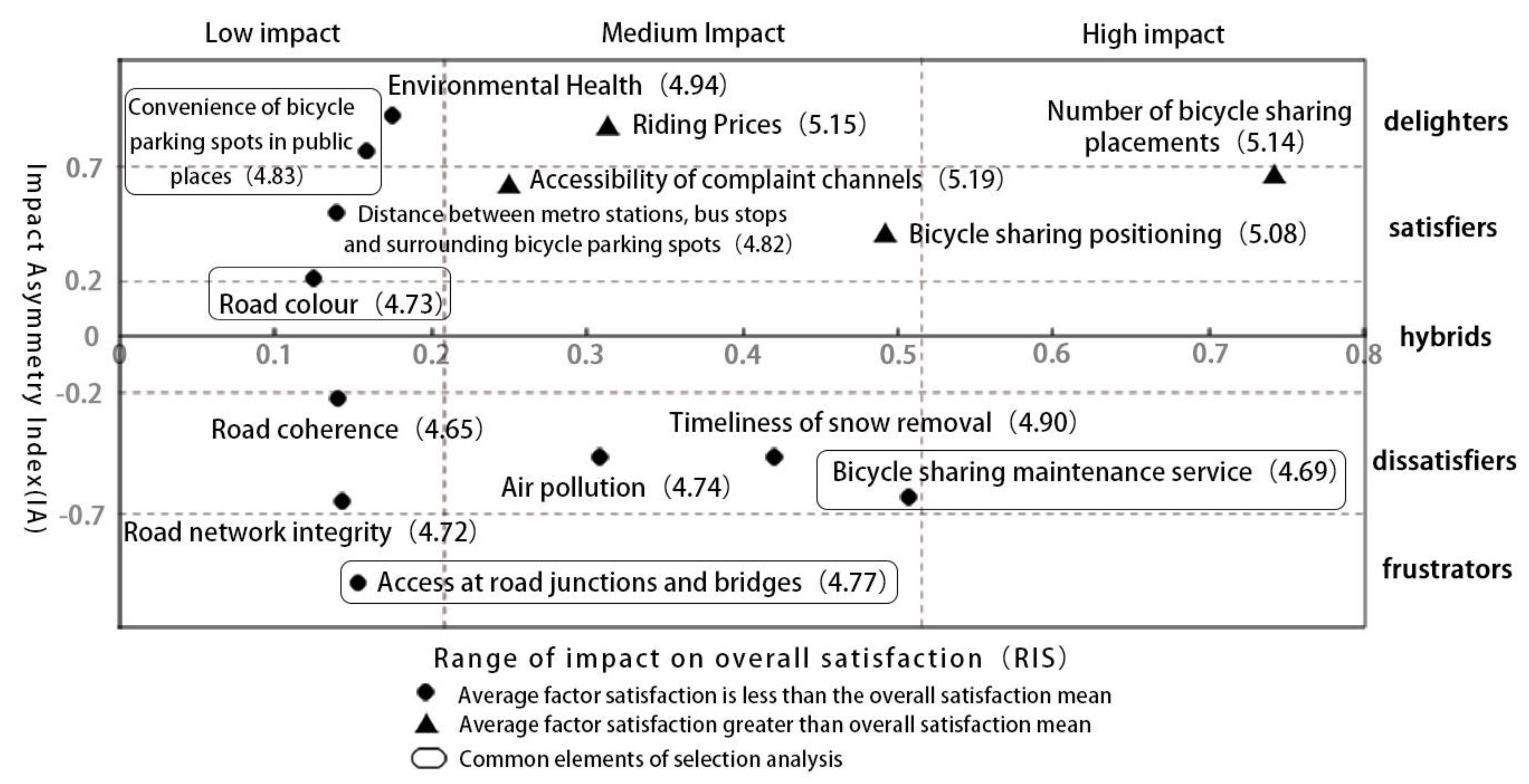
| First Level Indicator | Secondary Indicators | Tertiary Indicators |
|---|---|---|
| Comfort | Road surface condition | Width of cycle lanes |
| Road smoothness | ||
| Road colour | ||
| Waterlogging of roads | ||
| Timeliness of snow removal | ||
| Illegal occupation of cycle paths | ||
| Cycling environment | Architectural views and landmarks along the cycle path | |
| Greening effect | ||
| Air pollution | ||
| Environmental Health | ||
| Noise pollution | ||
| Safety | Road facilities | Road surface skid resistance |
| Street lighting | ||
| Segregation effect of the bicycle lane barrier | ||
| Cycling-related facilities at intersections | ||
| Crowd behaviour | Lane grabbing by motor vehicles and bicycles | |
| Occupation of cycle lanes by buses when parking | ||
| Retrograde traffic in cycle lanes | ||
| Bicycle body safety | Bicycle-sharing body mass | |
| Consistency | Road connections | Road coherence |
| Access at road junctions and bridges | ||
| Road network integrity | ||
| Operation | Bicycle parking | Distance between metro stations, bus stops, and surrounding bicycle parking spots |
| Convenience of bicycle parking spots in public places | ||
| Convenience of single car parking facilities in the community | ||
| Related services | Number of bicycle-sharing placements | |
| Bicycle-sharing maintenance service | ||
| Bicycle-sharing positioning | ||
| Time for the deposit to arrive after applying for a deposit refund | ||
| Accessibility of complaint channels | ||
| Riding prices |
| Urban Divisions | District Name | Road Name | Road Level | Presence or Absence of Nonmotorised Lanes | Whether There Is Any Motor Vehicle Traffic | Nonmotorised Lane Form | With Other Lane Splitting Methods | Whether There Is Green Separation Belt | Bicycle Signs or Not | Bike Lane Signage or Not | Nonmotorised Lane Width (m) |
|---|---|---|---|---|---|---|---|---|---|---|---|
| Olddistrict | Jingyu Business Circle, Daowai District | North Seventh Street | Secondary trunk road | No | Yes | No | No | No | No | No | No |
| Jingyang Street | Secondary trunk road | Yes | Yes | Motor and nonmotor vehicle separated | Road marking | No | No | No | 0.6 | ||
| Changchun Street | Branch road | No | Yes | No | No | No | No | No | No | ||
| Central Street Business Circle, Daoli District | Youyi Road | Arterial road | Yes | No | Motor and nonmotor vehicle separated | Road marking | No | Yes | No | 0.7 | |
| Shangzhi Street | Secondary trunk road | Yes | No | Motor and nonmotor vehicle separated | Road marking | No | Yes | No | 1.2 | ||
| Stalin Street | Branch road | No | Yes | No | No | No | No | No | No | ||
| Songbei Business Circle, Nangang District | Dongdaizhi Street | Arterial road | One sided with road | Yes | Motor and nonmotor vehicle separated | Road marking | No | No | No | 0.7 | |
| Minyi Street | Secondary trunk road | No | Yes | No | No | No | No | No | No | ||
| Post Street | Branch road | No | Yes | No | No | No | No | No | No | ||
| Lesong Business Circle, Xiangfang District | Hexing Road | Arterial road | No | No | No | No | No | No | No | No | |
| Songxin Street | Branch road | Yes | Yes | Motor and nonmotor vehicle separated | Road marking | No | No | No | 2.0 | ||
| Xingfu Road | Branch road | No | Yes | No | No | No | No | No | No | ||
| New district | Wanda Business Circle, Haxibusiness District | Haxi Street | Arterial road | Yes | No | Motor and nonmotor vehicle separated | Road marking | No | Yes | No | 2.5 |
| Harmony Road | Arterial road | Yes | Yes | Motor and nonmotor vehicle separated | Road marking | No | Yes | Yes | 1.8 | ||
| Zhongxing Street | Secondary trunk road | Yes | Yes | Shared-use sidewalk | Road dividers | Yes | Yes | Yes | 1.5 | ||
| Wanxianghui Business Circle, Songbei District | World Trade Boulevard | Arterial road | Yes | Yes | Motor and nonmotor vehicle separated | Road marking | No | No | No | 1.2 | |
| Expo Road | Secondary trunk road | Yes | Yes | Shared-use sidewalk | Road dividers | Yes | Yes | No | 0.6 | ||
| Long Tang Street | Secondary trunk road | Yes | Yes | Motor and nonmotor vehicle separated | Road marking | No | No | No | 1.8 | ||
| Qunli Business Circle, Qunli New District | Qunli Avenue | Arterial road | Yes | No | Shared-use sidewalk | Road dividers | Yes | Yes | Yes | 2.0 | |
| Rongjiang Road | Secondary trunk road | Yes | Yes | Shared-use sidewalk | Road dividers | Yes | Yes | Yes | 2.0 | ||
| Yuanjiang Road | Branch road | Yes | Yes | Motor and nonmotor vehicle separated | Road marking | No | Yes | No | 0.7 |
| Demographic Information | Classification | Percentage | |
|---|---|---|---|
| Old Urban Area | New Urban Area | ||
| Gender | Male | 47.8% | 52.2% |
| Female | 52.2% | 47.8% | |
| Age | 12–18 years old | 6.6% | 2.2% |
| 19–35 years old | 48.4% | 71.3% | |
| 36–59 years old | 42.9% | 23.9% | |
| 60+ years old | 2.2% | 2.6% | |
| Academic qualifications | Junior high school and below | 2.7% | 2.6% |
| High school | 17.0% | 4.3% | |
| University | 61.5% | 82.6% | |
| Graduate and above | 18.7% | 10.4% | |
| Professional | Student | 31.3% | 51.3% |
| Commuter | 50.0% | 36.1% | |
| Individual worker | 2.7% | 2.6% | |
| Freelancer | 7.7% | 4.3% | |
| Retired | 3.3% | 2.6% | |
| Other | 4.9% | 3.0% | |
| Personal monthly income | <1000 | 16.5% | 34.3% |
| 1000–3834 | 34.1% | 23.9% | |
| 3835–5999 | 23.6% | 21.3% | |
| 6000–10,000 | 15.4% | 13.5% | |
| More than 10,000 | 10.4% | 7.0% | |
| Number of travel weeks | 1 or less | 27.4% | 28.7% |
| 2 to 3 times | 43.4% | 47.8% | |
| 4 to 7 times | 13.7% | 16.1% | |
| 8 to 10 times | 7.7% | 1.3% | |
| More than 10 times | 7.7% | 6.1% | |
| Length of travel | 0 to 10 min | 12.6% | 17.4% |
| 11–20 min | 33.5% | 40.8% | |
| 21–30 min | 29.7% | 26.1% | |
| 31–40 min | 12.1% | 12.4% | |
| 41–60 min | 4.9% | 3.2% | |
| 1 h or more | 7.1% | 5.5% | |
| Travel purpose | Go to work | 25.0% | 16.5% |
| Go to school | 9.2% | 17.0% | |
| Exercise | 21.9% | 21.9% | |
| Shopping | 19.4% | 16.0% | |
| Play | 21.6% | 25.2% | |
| Other | 2.8% | 3.3% | |
| Environmental Elements | Relative Importance (%) | RIOS | SGP | DGP | IA | Classification | Satisfaction Average |
|---|---|---|---|---|---|---|---|
| Cycling-related facilities at intersections | 12.22 | 0.48 | 0.15 | 0.85 | −0.69 | Dissatisfier | 3.78 |
| Road smoothness | 10.89 | 0.55 | 0.40 | 0.60 | −0.21 | Dissatisfier | 3.84 |
| Road network integrity | 8.94 | 0.35 | 0.09 | 0.91 | −0.82 | Frustrator | 3.68 |
| Convenience of bicycle parking spots in public places | 6.59 | 0.37 | 0.25 | 0.75 | −0.49 | Dissatisfier | 4.15 |
| Road coherence | 6.35 | 0.28 | 0.058 | 0.94 | −0.88 | Frustrator | 3.81 |
| Accessibility of complaint channels | 4.70 | 0.45 | 0.20 | 0.80 | −0.59 | Dissatisfier | 4.67 |
| Bicycle-sharing positioning | 4.09 | 0.28 | 0.08 | 0.92 | −0.83 | Frustrator | 4.43 |
| Road width | 4.05 | 0.19 | 0.19 | 0.81 | −0.62 | Dissatisfier | 3.86 |
| Access at road junctions and bridges | 3.77 | 0.18 | 0.95 | 0.05 | 0.90 | Delighter | 3.90 |
| Distance between metro stations, bus stops, and surrounding bicycle parking spots | 3.72 | 0.22 | 0.65 | 0.35 | 0.31 | Satisfier | 4.38 |
| Road slip resistance | 3.38 | 0.17 | 0.47 | 0.53 | −0.07 | Hybrid | 3.99 |
| Bicycle-sharing maintenance service | 3.05 | 0.14 | 0.92 | 0.08 | 0.84 | Delighter | 3.80 |
| Road colour | 2.89 | 0.13 | 0 | 1 | −1 | Frustrator | 3.90 |
| Number of bicycle-sharing placements | 2.24 | 0.17 | 0.61 | 0.39 | 0.22 | Satisfier | 4.62 |
| Travel distance | 2.22 | 0 | -- | -- | -- | -- | -- |
| Noise pollution | 2.17 | 0.15 | 0.90 | 0.10 | 0.80 | Delighter | 4.01 |
| Greening | 2.17 | 0.11 | 0.52 | 0.48 | 0.04 | Hybrid | 4.33 |
| Environmental Elements | Relative Importance (%) | RIOS | SGP | DGP | IA | Classification | Satisfaction Average |
|---|---|---|---|---|---|---|---|
| Number of bicycle-sharing placements | 15.58 | 0.74 | 0.83 | 0.17 | 0.65 | Satisfier | 5.14 |
| Bicycle-sharing maintenance service | 9.42 | 0.51 | 0.18 | 0.82 | −0.64 | Dissatisfier | 4.69 |
| Bicycle-sharing positioning | 8.49 | 0.49 | 0.71 | 0.29 | 0.41 | Satisfier | 5.08 |
| Riding prices | 7.92 | 0.31 | 0.92 | 0.08 | 0.84 | Delighter | 5.15 |
| Timeliness of snow removal | 6.67 | 0.42 | 0.26 | 0.74 | −0.48 | Dissatisfier | 4.90 |
| Environmental health | 5.97 | 0.18 | 0.95 | 0.05 | 0.90 | Delighter | 4.94 |
| accessibility of complaint channels | 4.67 | 0.25 | 0.80 | 0.20 | 0.61 | Satisfier | 5.19 |
| Convenience of bicycle parking spots in public places | 4.27 | 0.16 | 0.87 | 0.13 | 0.75 | Delighter | 4.83 |
| Air pollution | 3.65 | 0.31 | 0.26 | 0.74 | −0.48 | Dissatisfier | 4.74 |
| Distance between metro stations, bus stops, and surrounding bicycle parking spots | 3.29 | 0.14 | 0.75 | 0.25 | 0.50 | Satisfier | 4.82 |
| Road coherence | 2.53 | 0.14 | 0.38 | 0.62 | −0.24 | Dissatisfier | 4.65 |
| Road network integrity | 2.49 | 0.14 | 0.17 | 0.83 | −0.66 | Dissatisfier | 4.72 |
| Road colour | 2.48 | 0.13 | 0.62 | 0.38 | 0.24 | Satisfier | 4.73 |
| Access at road junctions and bridges | 2.24 | 0.15 | 0.01 | 0.99 | −0.99 | Frustrator | 4.77 |
Disclaimer/Publisher’s Note: The statements, opinions and data contained in all publications are solely those of the individual author(s) and contributor(s) and not of MDPI and/or the editor(s). MDPI and/or the editor(s) disclaim responsibility for any injury to people or property resulting from any ideas, methods, instructions or products referred to in the content. |
© 2023 by the authors. Licensee MDPI, Basel, Switzerland. This article is an open access article distributed under the terms and conditions of the Creative Commons Attribution (CC BY) license (https://creativecommons.org/licenses/by/4.0/).
Share and Cite
Zhao, L.; Fang, D.; Cao, Y.; Sun, S.; Han, L.; Xue, Y.; Zheng, Q. Impact-Asymmetric Analysis of Bike-Sharing Residents’ Satisfaction: A Case Study of Harbin, China. Sustainability 2023, 15, 1670. https://doi.org/10.3390/su15021670
Zhao L, Fang D, Cao Y, Sun S, Han L, Xue Y, Zheng Q. Impact-Asymmetric Analysis of Bike-Sharing Residents’ Satisfaction: A Case Study of Harbin, China. Sustainability. 2023; 15(2):1670. https://doi.org/10.3390/su15021670
Chicago/Turabian StyleZhao, Lixuan, Dewei Fang, Yang Cao, Shan Sun, Liu Han, Yang Xue, and Qian Zheng. 2023. "Impact-Asymmetric Analysis of Bike-Sharing Residents’ Satisfaction: A Case Study of Harbin, China" Sustainability 15, no. 2: 1670. https://doi.org/10.3390/su15021670




